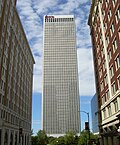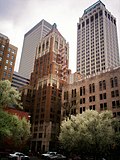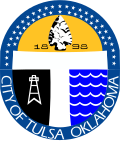| 1910 to 1919 |
| Image | Building | Date | Architect | Notes |
|---|
| Lyric Theatre, 103 S. Main St. | built 1891 | | (800 seats) Tulsa's first masonry theatre structure, presented vaudeville & motion pictures until converted to retail use in 1959. Demolished by Urban Renewal 1971. |
| Grand Opera House, 115 E. 2nd St. | Built in 1906 | John Eberson | (1,200 seats) Converted to furniture store, then an auction house. Demolished for Urban Renewal project 1973. |
| Orpheum Theater, 12 E. 4th St. | 1924 | John Eberson | (1,600 seats) Originally a Vaudeville theater. Converted to movie theater in 1931. Held world premiers for The Song of Bernadette and Tulsa . Demolished in 1970. |
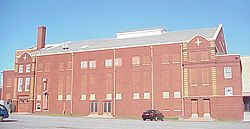 | Tulsa Theater | 1912-14, remodeled 1930, additions 1952 | 1930 remodel, Bruce Goff | Still in use as 3200 seat performing arts center. |
| Majestic Theater, 406 S. Main St. | 1917 | | (1,000 seats) Beau Arts style. First theater in Tulsa designed for movies, first in Tulsa with sound system, and first in Tulsa with Pipe Organ. Showed first talkie in Tulsa and first 3-D movie in Tulsa. Destroyed by fire 1973. |
| Rialto Theater, 7 W. 3rd St.(AKA-Orpheum) | 1917 | John Eberson | (1,400 seats) This was Tulsa's second Rialto, first sat next door at 13 W. 3rd. First theater in Tulsa to have air-conditioning. Demolished 1971. |
| Akdar Theatre, (Cimarron Ballroom), 221 W. 4th St. | 1925 | George & Leo Rapp | (1,800 seats) Built in exotic Moorish & Roccoco style. Converted to ballroom use 1946. Demolished in 1965. |
| Ritz Theater, 18 W. 4th St. | 1926 | John Eberson | (1,600 seats) Italian style atmospheric theater, demolished in 1963. Remaining Ritz Building demolished in 1973 |
| Fairgrounds Pavilion , Tulsa State Fairgrounds | 1932 | Leland I Shumway | (6,000 seats) Art Deco PWA. Photo looking west in the 1960s toward downtown Tulsa skyline |
 | Cain's Ballroom | 1924 | | Listed on the National Register of Historic Places. |
| Tulsa Coliseum , 502 S Elgin Ave. | 1928 | Leon Senter | (4,200 seats) Destroyed by fire September 1952 |
 | Circle Cinema , 10 S. Lewis Ave. | 1928 | | (800 seats) Listed on the National Register of Historic Places. |
| State Theater, 118 S. Main | Opened 1911 as Wonderland Nickelodeon | 1935 Art Deco remodel by Joseph R. Koberling, Jr. | (400 seats) Art Deco (Streamline style). Converted to retail store 1955. Demolished 1973 |
| Loew's Delman Theater, 2335 E. 15th St. | 1938 | W. Scott Dunne | (1,400 seats) Art Deco (Streamline style). Closed 1980. Demolished 2008. |
| Tulsa Theatre, 215 S. Main St. | 1941 | Jack Corgan & William J. Moore | (1,000 seats) Art Deco (Streamline style). Demolished by Urban Renewal 1971. |
| Will Rogers Theater, 4502 East 11th Street | 1941 | Jack Corgan | (900 seats) Southwestern style Art Deco (Streamline style). Demolished 1977 |
| Loew's Brook Theatre, 3307 South Peoria Avenue | 1945 | Willim H.C. Calderwood | (800 seats) Art Deco (Streamline style) Ceased movie presentation in 1983, and has since been converted to a restaurant. |
| Big Ten Ballroom (American Beauty), 1632 East Apache Street | 1950 | | Art Deco (Streamline style). |
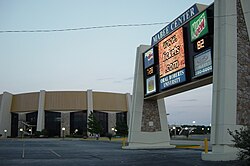 | Mabee Center , Oral Roberts University, 81st and Lewis | 1972 | Frank Wallace | |
| Cox Business Center, formerly known as Tulsa Convention Center, 6th and Houston | 1964 | | |
 | Tulsa Performing Arts Center | 1977 | Minoru Yamasaki | |
 | University of Tulsa, Reynolds Center | 1998 | | |
 | BOK Center | 2008 | César Pelli | |
|
